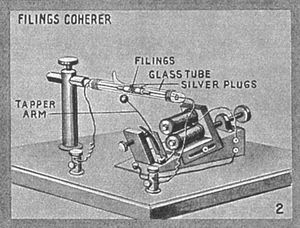Coherer: Difference between revisions
From ETHW
No edit summary |
No edit summary |
||
| (One intermediate revision by one other user not shown) | |||
| Line 1: | Line 1: | ||
<p>'''''This article is a stub. You can help the GHN by expanding it.''''' </p> | <p>'''''This article is a stub. You can help the GHN by expanding it.''''' </p> | ||
<p>Paris, France. On 24 November 1890, Édouard Branly | <p>Paris, France. On 24 November 1890, Édouard Branly invented the Coherer, a device important in the early development of [[Wireless Telegraphy|wireless telegraphy]]. The device, a glass tube with terminals containing metal filings, acts as an insulator unless acted upon by an electric spark, when it becomes a conductor. Tapping the device separates the filings and it again becomes an insulator. </p> | ||
<p>[[Image:Tapping coherer.jpg|thumb|center|Branly's Coherer]]</p> | |||
<p></p> | |||
<p></p> | |||
<p>[[Category:Communications]] [[Category:Telegraphy]]</p> | <p>[[Category:Communications]] [[Category:Telegraphy]]</p> | ||
Revision as of 15:48, 19 July 2010
This article is a stub. You can help the GHN by expanding it.
Paris, France. On 24 November 1890, Édouard Branly invented the Coherer, a device important in the early development of wireless telegraphy. The device, a glass tube with terminals containing metal filings, acts as an insulator unless acted upon by an electric spark, when it becomes a conductor. Tapping the device separates the filings and it again becomes an insulator.
